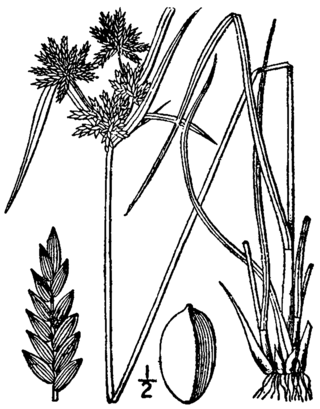
Cyperus papyrus, better known by the common names papyrus, papyrus sedge, paper reed, Indian matting plant, or Nile grass, is a species of aquatic flowering plant belonging to the sedge family Cyperaceae. It is a tender herbaceous perennial, native to Africa, and forms tall stands of reed-like swamp vegetation in shallow water.

Laburnum, sometimes called golden chain or golden rain, is a genus of two species of small trees in the subfamily Faboideae of the pea family Fabaceae. The species are Laburnum anagyroides—common laburnum and Laburnum alpinum—alpine laburnum. They are native to the mountains of southern Europe from France to the Balkans.

Cyperus is a large genus of about 700 species of sedges, distributed throughout all continents in both tropical and temperate regions.

Cyperus compressus, commonly known as annual sedge, is a sedge of the family Cyperaceae that has a wide distribution throughout countries with warmer climates. It is found in tropical areas of Africa, Asia and the Americas.

Cyperus surinamensis, also known as the tropical flatsedge, is a sedge of the family Cyperaceae that is native to the Americas.

Cyperus tenellus is a sedge of the family Cyperaceae commonly known as the tiny flatsedge.

Prismatocarpus is a genus of flowering plants belonging to the family Campanulaceae.
Cyperus prolixus is a species of sedge that is native to southern parts of North America, Central America and tropical parts of South America. It is a perennial plant that grows up to 2 meters tall. The leaves are long and narrow, and the flowers are small and white. Cyperus prolixus is found in a variety of habitats, including wetlands, meadows, and roadsides. It is a common plant and is not considered to be threatened or endangered.

Cyperus entrerianus, commonly known as the woodrush flatsedge, is a species of sedge that is native to southern parts of North America, Central America, and parts of South America.
Cyperus albus is a species of sedge that is native to southern parts of Africa.
Cyperus canus is a species of sedge that is native to parts of Mexico, Central America and northern South America.
Cyperus chalaranthus is a species of sedge that is native to parts of northern South America.
Cyperus rigens is a species of sedge that is native to parts of South America.
Cyperus sordidus is a species of sedge that is native to parts of Mexico.
Cyperus drummondii, commonly known as Drummond's sedge, is a species of sedge that is native to the southern parts of North America, parts of Central America, and northern parts of South America.

Cyperus hermaphroditus, commonly known as the hermaphrodite flatsedge, is a species of sedge that is native to parts of southern parts of North America, Central America and northern parts of South America.

Cyperus houghtonii, commonly known as Houghton's flatsedge, is a species of sedge that is native to parts of North America.
Cyperus planifolius, commonly known as flatleaf flatsedge, is a species of sedge that is native to southern parts of North America, Central America, the Caribbean, and northern parts of South America.
Cyperus schweinitzii is a species of sedge that is native to parts of North America.









